Abstract
Changes in the formation of antibodies to sheep red blood cells (sRBC) in the presence of Brucella extracts was studied in mice whose spleen cells were assayed by the Jerne procedure. Two strains of female mice were employed. Brucella extracts were prepared: (i) by trichloroacetic acid extraction (LPSN), (ii) by phenol extraction (LPS), and (iii) by hot acetic acid hydrolysis (Ps). B. abortus LPSN and B. melitensis LPSN or LPS, administered with sRBC, stimulated the specific response to sRBC, but only at high doses of endotoxins. B. abortus LPSN and B. melitensis LPSN suppressed nonspecific responses against horse red blood cells (hRBC), in contrast to the typical events following administration of Serratia marcescens endotoxin (or endotoxins from other ubiquitous organisms). In CD-1 mice, B. abortus Ps depressed the specific anti-sRBC response. Attempts to presensitize mice with abortus LPSN resulted in a stimulation of the response to sRBC, but pretreatment with B. melitensis LPSN had an inhibitory effect. When injected alone, Brucella endotoxins activated anti-sRBC antibody-forming cells but not anti-hRBC cells. B. abortus Ps was unable to modify the background number of anti-sRBC cells and inhibited the hRBC response. These data suggest (i) that there exists a “common antigen” between Brucella cells and sRBC and (ii) that the so-called primary response to endotoxins from ubiquitous organisms represents a secondary response to already naturally sensitized animals.
Full text
PDF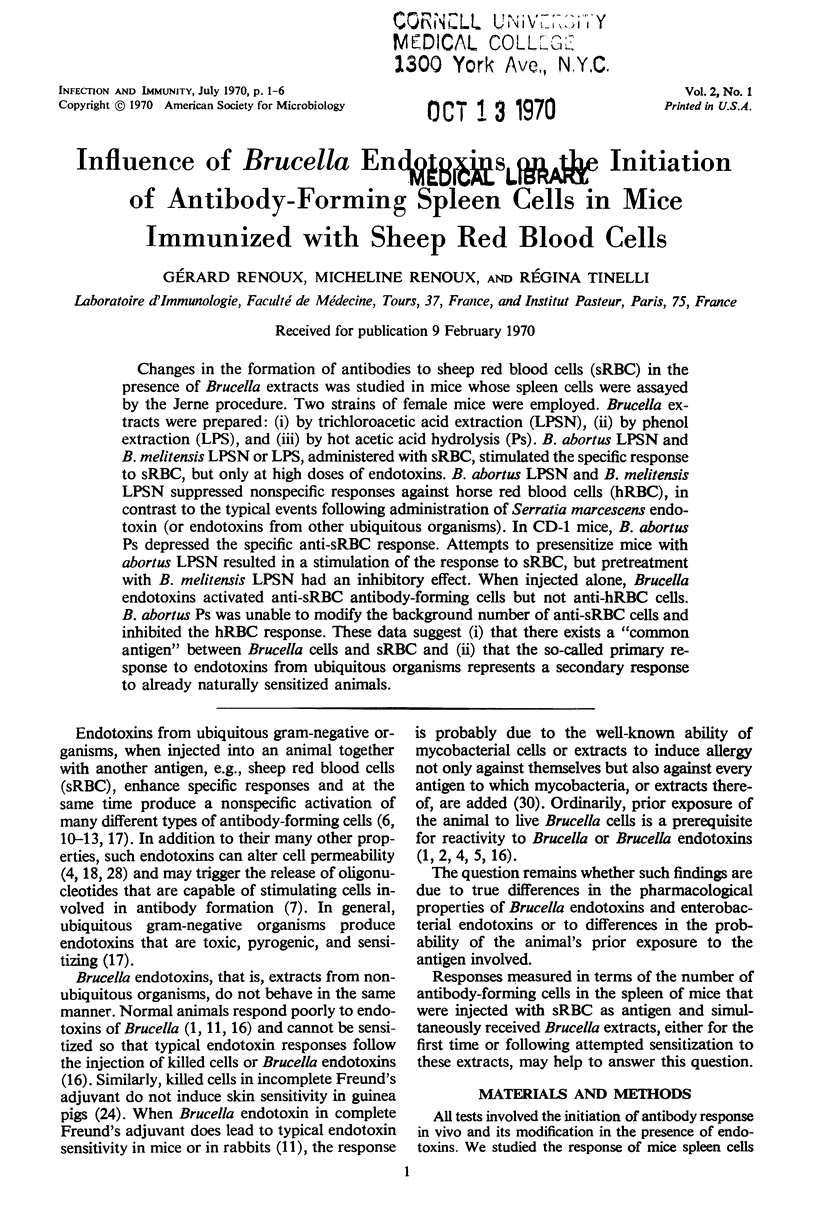
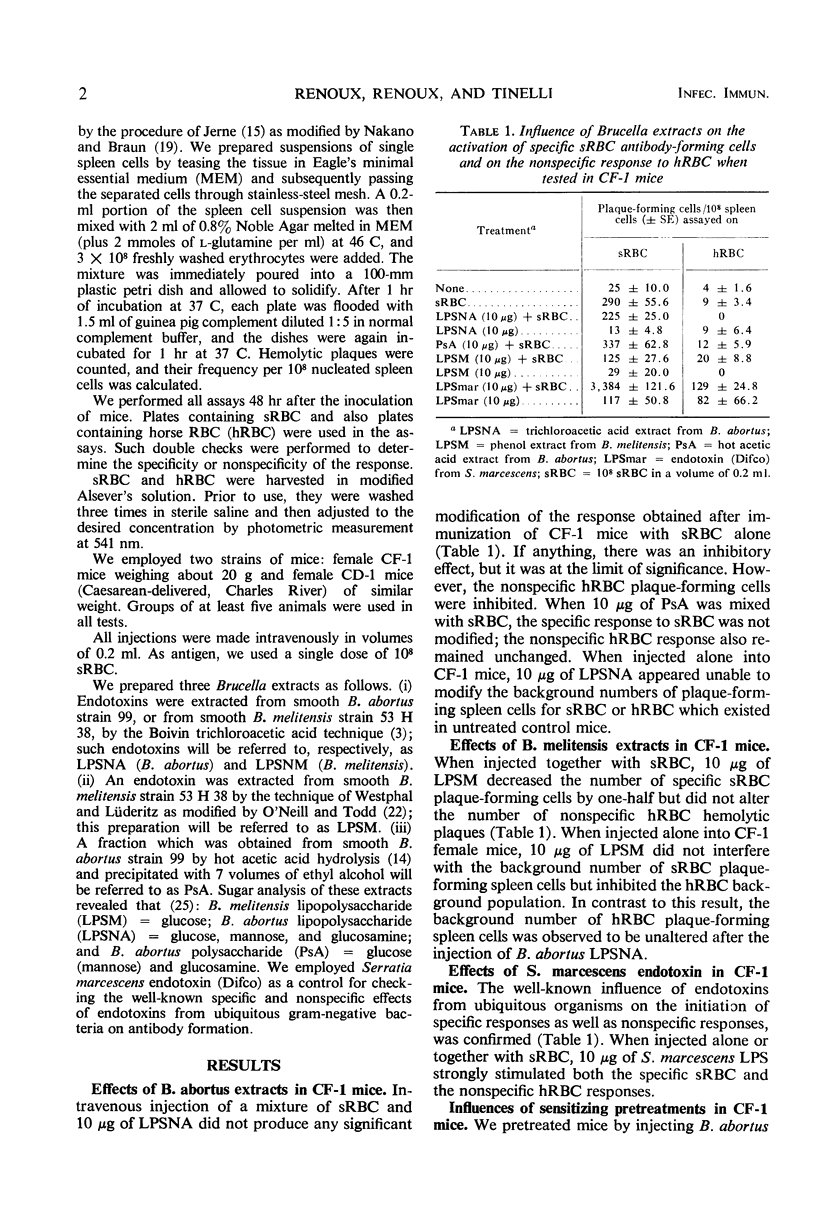
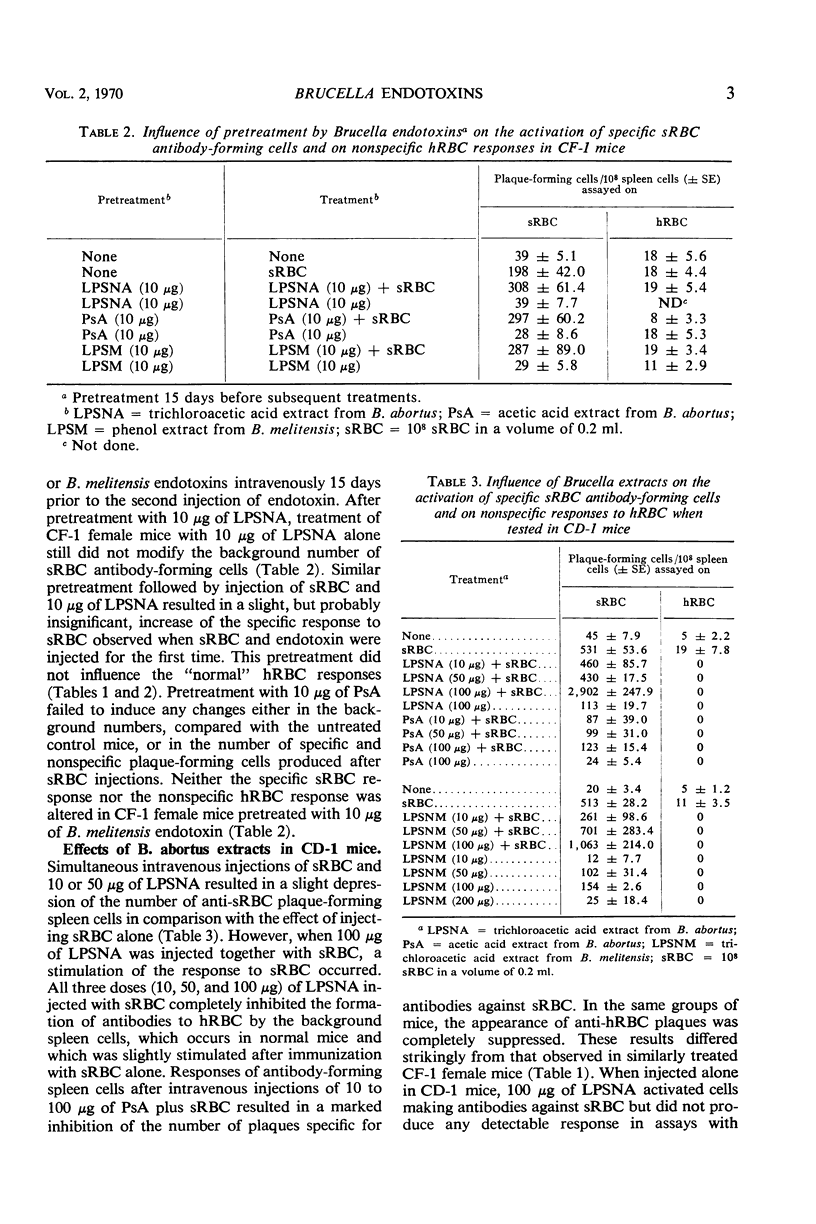
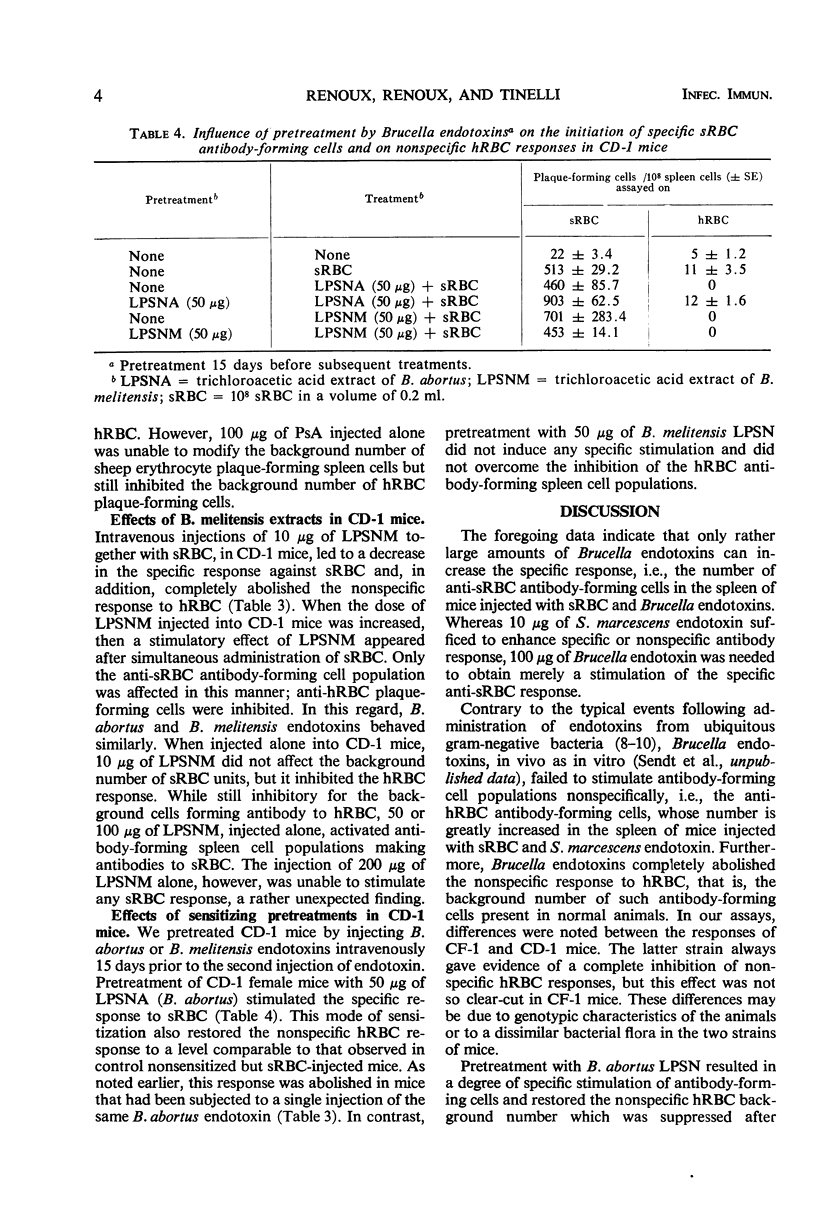
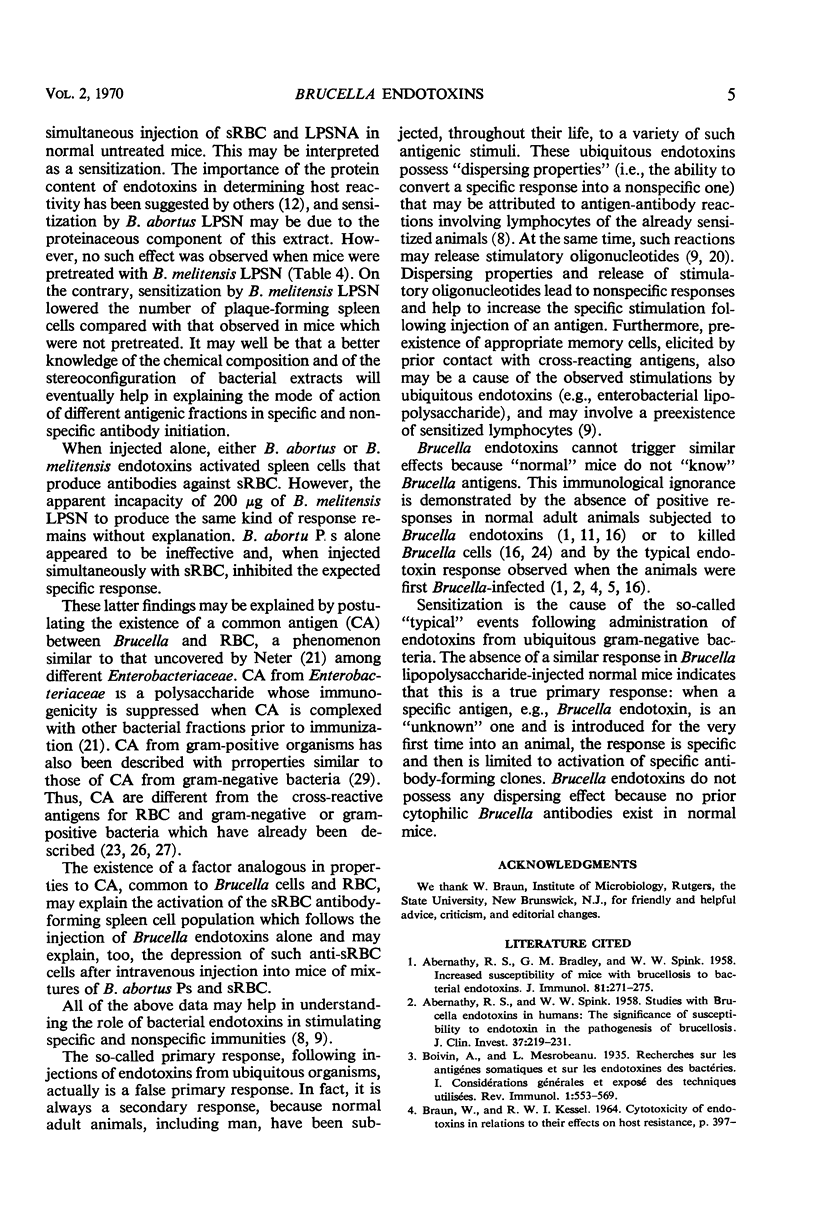
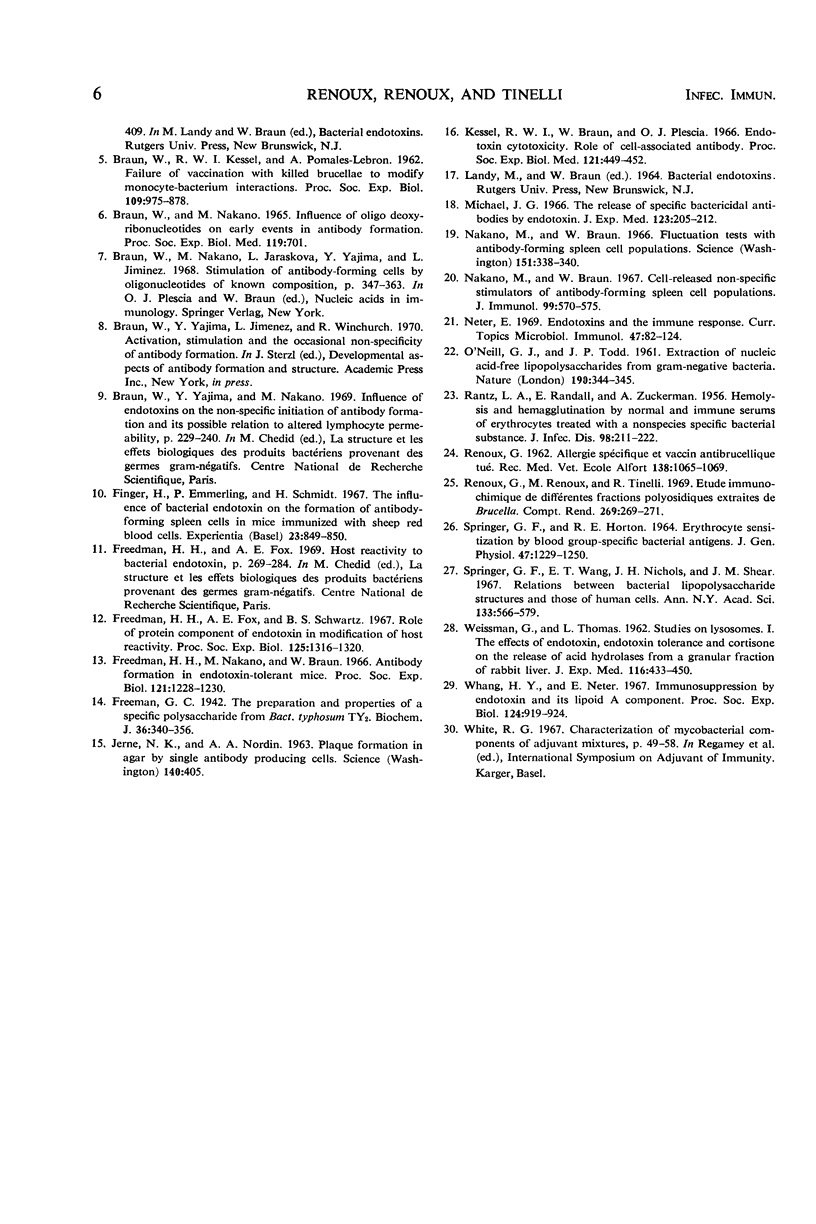
Selected References
These references are in PubMed. This may not be the complete list of references from this article.
- ABERNATHY R. S., BRADLEY G. M., SPINK W. W. Increased susceptibility of mice with brucellosis to bacterial endotoxins. J Immunol. 1958 Oct;81(4):271–275. [PubMed] [Google Scholar]
- ABERNATHY R. S., SPINK W. W. Studies with Brucella endotoxin in humans: the significance of susceptibility to endotoxin in the pathogenesis of brucellosis. J Clin Invest. 1958 Feb;37(2):219–231. doi: 10.1172/JCI103601. [DOI] [PMC free article] [PubMed] [Google Scholar]
- BRAUN W., NAKANO M. INFLUENCE OF OLIGODEOXYRIBONUCLEOTIDES ON EARLY EVENTS IN ANTIBODY FORMATION. Proc Soc Exp Biol Med. 1965 Jul;119:701–707. doi: 10.3181/00379727-119-30276. [DOI] [PubMed] [Google Scholar]
- Finger H., Emmerling P., Schmidt H. The influence of bacterial endotoxin on the formation of antibody-forming spleen cells in mice immunized with sheep red blood cells. Experientia. 1967 Oct 15;23(10):849–850. doi: 10.1007/BF02146884. [DOI] [PubMed] [Google Scholar]
- Freedman H. H., Fox A. E., Willis R. S., Schwartz B. S. Role of protein component of endotoxin in modification of host reactivity. Proc Soc Exp Biol Med. 1967 Aug-Sep;125(4):1316–1320. doi: 10.3181/00379727-125-32346. [DOI] [PubMed] [Google Scholar]
- Freedman H. H., Nakano M., Braun W. Antibody formation in endotoxin-tolerant mice. Proc Soc Exp Biol Med. 1966 Apr;121(4):1228–1230. doi: 10.3181/00379727-121-31012. [DOI] [PubMed] [Google Scholar]
- Freeman G. G. The preparation and properties of a specific polysaccharide from Bact. typhosum Ty(2): With an addendum by J. St L. Philpot, From the Department of Biochemistry, Oxford. Biochem J. 1942 Apr;36(3-4):340–356. doi: 10.1042/bj0360340. [DOI] [PMC free article] [PubMed] [Google Scholar]
- Jerne N. K., Nordin A. A. Plaque Formation in Agar by Single Antibody-Producing Cells. Science. 1963 Apr 26;140(3565):405–405. doi: 10.1126/science.140.3565.405. [DOI] [PubMed] [Google Scholar]
- Kessel R. W., Braun W., Plescia O. J. Endotoxin cytotoxicity: role of cell-associated antibody. Proc Soc Exp Biol Med. 1966 Feb;121(2):449–452. doi: 10.3181/00379727-121-30801. [DOI] [PubMed] [Google Scholar]
- Michael J. G. The release of specific bactericidal antibodies by endotoxin. J Exp Med. 1966 Feb 1;123(2):205–212. doi: 10.1084/jem.123.2.205. [DOI] [PMC free article] [PubMed] [Google Scholar]
- Nakano M., Braun W. Cell-released non-specific stimulatiors of antibody-forming spleen cell populations. J Immunol. 1967 Sep;99(3):570–575. [PubMed] [Google Scholar]
- Nakano M., Braun W. Fluctuation tests with antibody-forming spleen cell populations. Science. 1966 Jan 21;151(3708):338–340. doi: 10.1126/science.151.3708.338. [DOI] [PubMed] [Google Scholar]
- Neter E. Endotoxins and the immune response. Curr Top Microbiol Immunol. 1969;47:82–124. doi: 10.1007/978-3-642-46160-6_5. [DOI] [PubMed] [Google Scholar]
- O'NEILL G. J., TODD J. P. Extraction of nucleic acid-free lipopolysaccharides from gram-negative bacteria. Nature. 1961 Apr 22;190:344–345. doi: 10.1038/190344b0. [DOI] [PubMed] [Google Scholar]
- RANTZ L. A., RANDALL E., ZUCKERMAN A. Hemolysis and hemagglutination by normal and immune serums of erythrocytes treated with a nonspecies specific bacterial substance. J Infect Dis. 1956 Mar-Apr;98(2):211–222. doi: 10.1093/infdis/98.2.211. [DOI] [PubMed] [Google Scholar]
- Renoux G., Renoux M., Tinelli R. Etude immunochimique de différentes fractions polyosidiques extraites de Brucella. C R Acad Sci Hebd Seances Acad Sci D. 1969 Jul 16;269(2):269–271. [PubMed] [Google Scholar]
- SPRINGER G. F., HORTON R. E. ERYTHROCYTE SENSITIZATION BY BLOOD GROUP-SPECIFIC BACTERIAL ANTIGENS. J Gen Physiol. 1964 Jul;47:1229–1250. doi: 10.1085/jgp.47.6.1229. [DOI] [PMC free article] [PubMed] [Google Scholar]
- Springer G. F., Wang E. T., Nichols J. H., Shear J. M. Relations between bacterial lipopolysaccharide structures and those of human cells. Ann N Y Acad Sci. 1966 Jun 30;133(2):566–579. doi: 10.1111/j.1749-6632.1966.tb52389.x. [DOI] [PubMed] [Google Scholar]
- WEISSMANN G., THOMAS L. Studies on lysosomes. I. The effects of endotoxin, endotoxin tolerance, and cortisone on the release of acid hydrolases from a granular fraction of rabbit liver. J Exp Med. 1962 Oct 1;116:433–450. doi: 10.1084/jem.116.4.433. [DOI] [PMC free article] [PubMed] [Google Scholar]
- Whang H. Y., Neter E. Immunosuppression by endotoxin and its lipoid A component. Proc Soc Exp Biol Med. 1967 Mar;124(3):919–924. doi: 10.3181/00379727-124-31886. [DOI] [PubMed] [Google Scholar]


